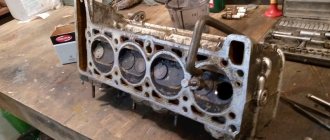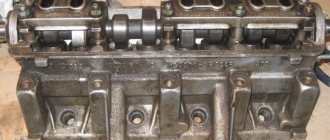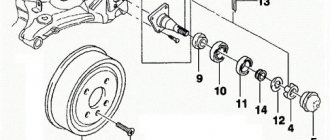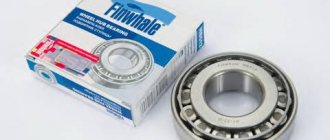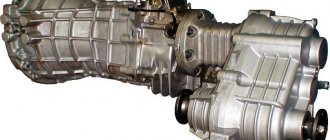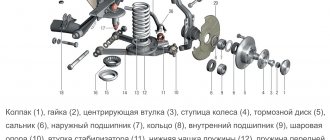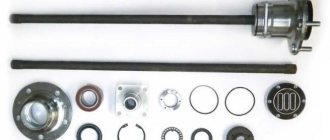About the wheel mounting design
The fact that the wheel nuts are a special product is evidenced by a non-standard metric thread with a diameter of 12 mm with a pitch of 1.25 mm. Standard coils of the same diameter have a different pitch, 1.75 mm. That is, the wheel threads are made smaller in order to increase the reliability of the connection and implement the “self-tightening” effect due to constant rotation. Larger coils will not work here.
The factory nuts are sized so that when the thick stamped steel wheel is tightened, they will fit completely onto the stud. In this case, the element is equipped with a cone at the end, adjacent to the mating part on the disk. Due to the cone-shaped connection, 2 problems are solved:
- self-centering of the hole in the disk opposite the stud when the nuts are evenly tightened;
- more reliable connection of the wheel plane with the hub.
The pin, which carries the load of the entire fastening, is pressed into the hub on splines with an interference fit, and it is sometimes very difficult to knock it out. This is another reason to take the selection of parts for this unit seriously. All nuts available for sale for Niva can be divided into 2 types:
- Open, the pin passes through them when twisted. The car is equipped with such parts at the manufacturer.
- Closed, with a blind hole. Installed on Chevrolet Niva, but the size is also suitable for VAZ-21213.
Factory elements are manufactured with a size for a 19 mm wheel wrench. Various parts found in stores can be made with a 21 mm turnkey, and reach a height of 30 mm or more. The standard length of the open VAZ-2121 nut, made of uncoated carbon steel, is 17 mm. The new decorative parts have a nickel plated finish and a different protruding head shape.
Block plane and gasket penetration
Loosen the fastening clamp and disconnect the hose of the lower thermostat pipe. Loosen the fastening clamp and disconnect the hose of the thermostat side pipe. Loosen the fastening clamp and disconnect the fluid supply hose to the heater radiator from the cylinder head pipe.
Unscrew the nuts of the fuel pipes and disconnect the fuel supply and drain lines. Remove the upper bolt securing the rear intake pipe strut, loosen the lower bolt of the strut and move it to the side.
Torsion bolts (plastically deformable)
Remove the two nuts securing the starter heat shield. Move the shield to the side. Remove the chain from the camshaft sprocket. Carefully place it on the tensioner shoe.
Why change the mount?
There are several reasons why Niva car owners change their wheel nuts to new ones:
Old nuts that are worn or mechanically damaged do need to be replaced, especially when they have poor threads or missing edges. It is difficult to tighten such a part with a torque of 10-11 kgf/m to securely fasten the wheel. It’s better to install a new set; it’s pointless to change 1-2 fasteners. The main thing is that the threaded part of the stud remains normal.
Alloy wheels, although thicker than stamped steel ones, can theoretically be fastened with factory nuts. Another thing is that such details will ruin the entire appearance of the new wheels, so in such a situation it is better to install elements that are in harmony with the wheel. There is another point: in some models of alloy wheels, samples are made in the form of a hemisphere, rather than a cone. Then the standard fasteners will definitely not fit; you need to purchase nuts with a spherical end that fit into the mating part of the rim.
In addition to improving the appearance of the car, there is another reason that forces you to change 1 out of 5 nuts to a special one that can only be turned with an exclusive key. The reason lies in the high cost of car tires and storing the car itself in the open air in the yard, as often happens in cities. To prevent tires from being stolen at night, one clever security nut is installed on the car.
Now about the tightening torque
Before fixing the cylinder head, carefully inspect the bolts. Their type is M12×1.25. Be sure to measure the threaded rods - be prepared to replace any element whose length is more than 11.7 centimeters. The fact is that they stretch during use, which means they no longer hold properly.
It is recommended to tighten the bolts in five stages. This will save you from having to tighten them additionally each time during preventive examinations.
In the first step, tighten all ten bolts by hand, and then tighten them in the correct sequence with a torque wrench, with a torque of 20 Nm.
2014-08-22
Wheel nuts-2
A short continuation about wheel nuts (see about the difference between nuts for casting and stamping).
A budget option for M12x1.25 wheel nuts are nuts from Niva. Here are two options:
On the left in the photo is a nut from a classic Niva. This is a stamping nut only, not recommended for use with alloy wheels. But on the right is a nut from a Chevrolet Niva. This nut can be used with alloy wheels.
These nuts will also fit the Jimny. Comparison with the original Dzhimnikov nut:
If you suddenly need nuts urgently, and there is an option only for the Sh. Niva, then you can take that too.
3 comments:
I saw the shiny one in the store, the one on the left in the last photo. At least it looks similar. The price is 45 rubles, if I'm not mistaken. Turnkey “for 17” and “for 19”. Actually, this is what I use (both casting and stamping). I have never used the one on the left in the first photo, although it could have happened.
Original Japanese nuts are good, but expensive. And cheap Chinese ones look beautiful, but they can be made from wild “raw meat”. I myself saw how chips were easily removed from such nuts when tightened with stamping (Dotz). :-/ “Shnivovskie” are not ideal, but, in principle, they will do as a last resort at their low price (I recently bought them for 35 rubles apiece). But, of course, you need to take into account the thread (M12x1.25 is not used everywhere).
“The shavings were removed” is, of course, complete chaos. These will go straight to the ferrous metal (if accepted ;-)). But the thread of the studs will not be damaged by the “silumin”.
